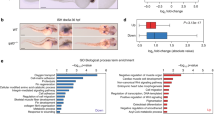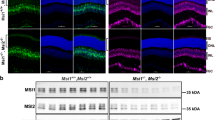Abstract
EphAs and ephrinAs are expressed in multiple areas of the developing brain in overlapping countergradients, notably in the retina and tectum. Here they are involved in targeting retinal axons to their correct topographic position in the tectum. We have used truncated versions of EphA3, single–amino acid point mutants of ephrinA5 and fluorescence resonance energy transfer technology to uncover a cis interaction between EphA3 and ephrinA5 that is independent of the established ligand-binding domain of EphA3. This cis interaction abolishes the induction of tyrosine phosphorylation of EphA3 and results in a loss of sensitivity of retinal axons to ephrinAs in trans. Our data suggest that formation of this complex transforms the uniform expression of EphAs in the nasal part of the retina into a gradient of functional EphAs and has a key role in controlling retinotectal mapping.
This is a preview of subscription content, access via your institution
Access options
Subscribe to this journal
Receive 12 print issues and online access
$209.00 per year
only $17.42 per issue
Buy this article
- Purchase on Springer Link
- Instant access to full article PDF
Prices may be subject to local taxes which are calculated during checkout





Similar content being viewed by others
References
McLaughlin, T. & O'Leary, D.D. Molecular gradients and development of retinotopic maps. Annu. Rev. Neurosci. 28, 327–355 (2005).
Klein, R. Eph/ephrin signaling in morphogenesis, neural development and plasticity. Curr. Opin. Cell Biol. 16, 580–589 (2004).
Poliakov, A., Cotrina, M. & Wilkinson, D.G. Diverse roles of eph receptors and ephrins in the regulation of cell migration and tissue assembly. Dev. Cell 7, 465–480 (2004).
Pasquale, E.B. Eph-ephrin promiscuity is now crystal clear. Nat. Neurosci. 7, 417–418 (2004).
Kullander, K. & Klein, R. Mechanisms and functions of eph and ephrin signalling. Nat. Rev. Mol. Cell Biol. 3, 475–486 (2002).
Knöll, B. & Drescher, U. Ephrin-As as receptors in topographic projections. Trends Neurosci. 25, 145–149 (2002).
McLaughlin, T., Hindges, R. & O'Leary, D.D. Regulation of axial patterning of the retina and its topographic mapping in the brain. Curr. Opin. Neurobiol. 13, 57–69 (2003).
Rashid, T. et al. Opposing gradients of Ephrin-As and EphA7 in the superior colliculus are essential for topographic mapping in the mammalian visual system. Neuron 47, 57–69 (2005).
Yates, P.A., Roskies, A.L., McLaughlin, T. & O'Leary, D.D. Topographic-specific axon branching controlled by ephrin-as is the critical event in retinotectal map development. J. Neurosci. 21, 8548–8563 (2001).
Yates, P.A., Holub, A.D., McLaughlin, T., Sejnowski, T.J. & O'Leary, D.D. Computational modeling of retinotopic map development to define contributions of EphA-ephrinA gradients, axon-axon interactions, and patterned activity. J. Neurobiol. 59, 95–113 (2004).
Hornberger, M.R. et al. Modulation of EphA receptor function by coexpressed ephrinA ligands on retinal ganglion cell axons. Neuron 22, 731–742 (1999).
Feldheim, D.A. et al. Topographic guidance labels in a sensory map to the forebrain. Neuron 21, 1303–1313 (1998).
Erskine, L. et al. Retinal ganglion cell axon guidance in the mouse optic chiasm: expression and function of robos and slits. J. Neurosci. 20, 4975–4982 (2000).
Niclou, S.P., Jia, L. & Raper, J.A. Slit2 is a repellent for retinal ganglion cell axons. J. Neurosci. 20, 4962–4974 (2000).
Ringstedt, T. et al. Slit inhibition of retinal axon growth and its role in retinal axon pathfinding and innervation patterns in the diencephalon. J. Neurosci. 20, 4983–4991 (2000).
Varela-Echavarria, A., Tucker, A., Puschel, A.W. & Guthrie, S. Motor axon subpopulations respond differentially to the chemorepellents netrin-1 and semaphorin D. Neuron 18, 193–207 (1997).
Chen, H., Chedotal, A., He, Z., Goodman, C.S. & Tessier-Lavigne, M. Neuropilin-2, a novel member of the neuropilin family, is a high affinity receptor for the semaphorins Sema E and Sema IV but not Sema III. Neuron 19, 547–559 (1997).
Labrador, J.P., Brambilla, R. & Klein, R. The N-terminal globular domain of Eph receptors is sufficient for ligand binding and receptor signaling. EMBO J. 16, 3889–3897 (1997).
Sobieszczuk, D.F. & Wilkinson, D.G. Masking of Eph receptors and ephrins. Curr. Biol. 9, R469–R470 (1999).
Miao, H. et al. Activation of EphA receptor tyrosine kinase inhibits the Ras/MAPK pathway. Nat. Cell Biol. 3, 527–530 (2001).
Himanen, J.P. & Nikolov, D.B. Eph signaling: a structural view. Trends Neurosci. 26, 46–51 (2003).
Himanen, J.P. et al. Repelling class discrimination: ephrin-A5 binds to and activates EphB2 receptor signaling. Nat. Neurosci. 7, 501–509 (2004).
Ciossek, T., Lerch, M.M. & Ullrich, A. Cloning, characterization, and differential expression of MDK2 and MDK5, two novel receptor tyrosine kinases of the eck/eph family. Oncogene 11, 2085–2095 (1995).
Scatchard, G. The attractions of protein for small molecules and ions Ann. NY. Acad. Sci. 51, 660–672 (1949).
Marston, D.J., Dickinson, S. & Nobes, C.D. Rac-dependent trans-endocytosis of ephrinBs regulates Eph-ephrin contact repulsion. Nat. Cell Biol. 5, 879–888 (2003).
Zimmer, M., Palmer, A., Kohler, J. & Klein, R. EphB-ephrinB bi-directional endocytosis terminates adhesion allowing contact mediated repulsion. Nat. Cell Biol. 5, 869–878 (2003).
Soond, S.M., Everson, B., Riches, D.W. & Murphy, G. ERK-mediated phosphorylation of Thr735 in TNFalpha-converting enzyme and its potential role in TACE protein trafficking. J. Cell Sci. 118, 2371–2380 (2005).
Bastiaens, P.I. & Jovin, T.M. Fluorescence resonance energy transfer microscopy. in Cell Biology: A Laboratory Handbook (ed. Celis, J.E.) 136–146 (Academic Press, New York, 1998).
Ehehalt, R., Keller, P., Haass, C., Thiele, C. & Simons, K. Amyloidogenic processing of the Alzheimer beta-amyloid precursor protein depends on lipid rafts. J. Cell Biol. 160, 113–123 (2003).
Wu, C., Butz, S., Ying, Y. & Anderson, R.G. Tyrosine kinase receptors concentrated in caveolae-like domains from neuronal plasma membrane. J. Biol. Chem. 272, 3554–3559 (1997).
Foster, L.J., De Hoog, C.L. & Mann, M. Unbiased quantitative proteomics of lipid rafts reveals high specificity for signaling factors. Proc. Natl. Acad. Sci. USA 100, 5813–5818 (2003).
Yin, Y. et al. EphA receptor tyrosine kinases interact with co-expressed ephrin-A ligands in cis. Neurosci. Res. 48, 285–296 (2004).
Gu, C. et al. The EphA8 receptor induces sustained MAP kinase activation to promote neurite outgrowth in neuronal cells. Oncogene 24, 4243–4256 (2005).
Böhme, B. et al. Cell-cell adhesion mediated by binding of membrane-anchored ligand LERK-2 to the EPH-related receptor human embryonal kinase 2 promotes tyrosine kinase activity. J. Biol. Chem. 271, 24747–24752 (1996).
Dravis, C. et al. Bidirectional signaling mediated by ephrin-B2 and EphB2 controls urorectal development. Dev. Biol. 271, 272–290 (2004).
Holmberg, J., Clarke, D.L. & Frisen, J. Regulation of repulsion versus adhesion by different splice forms of an Eph receptor. Nature 408, 203–206 (2000).
Marquardt, T. et al. Coexpressed EphA receptors and ephrin-A ligands mediate opposing actions on growth cone navigation from distinct membrane domains. Cell 121, 127–139 (2005).
Davy, A. et al. Compartmentalized signaling by GPI-anchored ephrinA5 requires the fyn tyrosine kinase to regulate cellular adhesion. Gen. Dev. 13, 3125–3135 (1999).
Paratcha, G. et al. Released GFRalpha1 potentiates downstream signaling, neuronal survival, and differentiation via a novel mechanism of recruitment of c-Ret to lipid rafts. Neuron 29, 171–184 (2001).
Egea, J. et al. Regulation of EphA 4 kinase activity is required for a subset of axon guidance decisions suggesting a key role for receptor clustering in Eph function. Neuron 47, 515–528 (2005).
Reber, M., Burrola, P. & Lemke, G. A relative signalling model for the formation of a topographic neural map. Nature 431, 847–853 (2004).
Goodhill, G.J., Gu, M. & Urbach, J.S. Predicting axonal response to molecular gradients with a computational model of filopodial dynamics. Neural Comput. 16, 2221–2243 (2004).
Loschinger, J., Weth, F. & Bonhoeffer, F. Reading of concentration gradients by axonal growth cones. Phil. Trans. R. Soc. Lond. B 355, 971–982 (2000).
Drescher, U. et al. In vitro guidance of retinal ganglion cell axons by RAGS, a 25 kDa tectal protein related to ligands for Eph receptor tyrosine kinases. Cell 82, 359–370 (1995).
Connor, R.J., Menzel, P. & Pasquale, E.B. Expression and tyrosine phosphorylation of Eph receptors suggest multiple mechanisms in patterning of the visual system. Dev. Biol. 193, 21–35 (1998).
Burack, M.A., Silverman, M.A. & Banker, G. The role of selective transport in neuronal protein sorting. Neuron 26, 465–472 (2000).
Monschau, B. et al. Shared and distinct functions of RAGS and ELF-1 in guiding retinal axons. EMBO J. 16, 1258–1267 (1997).
Toth, J. et al. Crystal structure of an ephrin ectodomain. Dev. Cell 1, 83–92 (2001).
Himanen, J.P. & Nikolov, D.B. Purification, crystallization and preliminary characterization of an Eph-B2/ephrin-B2 complex. Acta Crystallogr. D Biol. Crystallogr. 58, 533–535 (2002).
Hansen, M.J., Dallal, G.E. & Flanagan, J.G. Retinal axon response to ephrinAs shows a graded, concentration-dependent transition from growth promotion to inhibition. Neuron 42, 717–730 (2004).
Acknowledgements
We thank V. Sundaresan (King's College, London) for providing Robo2-MYC and A. Ullrich (Max-Plank-Institut for Biochemistry, Munich) for the PDGF-R vector; S. Kümper and A. Snedden for cloning Eph and ephrin constructs; and C. Jarvis, P. Gordon-Weeks, and R. Drescher for critical reading of the manuscript. This work was supported by the Wellcome Trust. R. Carvalho is a student of the Gulbenkian PhD Program in Biomedicine, Portugal. M. Beutler was supported by Deutsche Forschungs Gemeinschaft (HE 3492/2-1), Schwerpunktprogram (SPP)1128 & Higher Education Funding Council England (HEFCE). T. Ng is supported by an endowment fund from the Richard Dimbleby Cancer Fund to King's College London.
Author information
Authors and Affiliations
Corresponding author
Ethics declarations
Competing interests
The authors declare no competing financial interests.
Supplementary information
Supplementary Fig. 1
The PDGF receptor does not coimmunoprecipitate with ephrinA5. (PDF 419 kb)
Supplementary Fig. 2
Models for cis and trans interactions between EphAs and ephrinAs. (PDF 1502 kb)
Supplementary Fig. 3
Analysis of the availability of the LBD of EphA3 in cells coexpressing EphA3/ephrinA5wt (EphA3/ephrinA5E129K). (PDF 335 kb)
Supplementary Fig. 4
Characteristics of the binding of EphA3 to ephrinA5wt or ephrinA5E129K. (PDF 514 kb)
Supplementary Fig. 5
Donor (CFP) dequenching under acceptor (YFP) depletion. (PDF 876 kb)
Rights and permissions
About this article
Cite this article
Carvalho, R., Beutler, M., Marler, K. et al. Silencing of EphA3 through a cis interaction with ephrinA5. Nat Neurosci 9, 322–330 (2006). https://doi.org/10.1038/nn1655
Received:
Accepted:
Published:
Issue Date:
DOI: https://doi.org/10.1038/nn1655
This article is cited by
-
Overexpression of EphB6 and EphrinB2 controls soma spacing of cortical neurons in a mutual inhibitory way
Cell Death & Disease (2023)
-
Reduction of ephrin-A5 aggravates disease progression in amyotrophic lateral sclerosis
Acta Neuropathologica Communications (2019)
-
Eph receptor signalling: from catalytic to non-catalytic functions
Oncogene (2019)
-
Ephrin ligands and Eph receptors contribution to hematopoiesis
Cellular and Molecular Life Sciences (2017)
-
Mechanisms of ephrin–Eph signalling in development, physiology and disease
Nature Reviews Molecular Cell Biology (2016)



